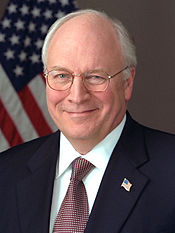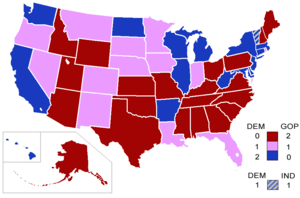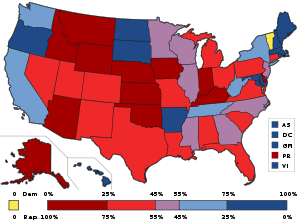- 109th United States Congress
-
109th United States Congress 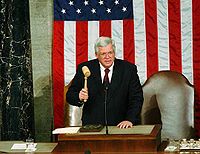
Speaker Hastert (2006)Duration: January 3, 2005 – January 3, 2007 Senate President: Dick Cheney (R) Senate Pres. pro tem: Ted Stevens (R) House Speaker: Dennis Hastert (R) Members: 100 Senators
435 Representatives
5 Non-voting membersSenate Majority: Republican Party House Majority: Republican Party Sessions 1st: January 4, 2005 – December 22, 2005
2nd: January 3, 2006 – December 8, 2006<108th 110th> The One Hundred Ninth United States Congress was the legislative branch of the United States, composed of the United States Senate and the United States House of Representatives, from January 3, 2005 to January 3, 2007, during the fifth and sixth years of George W. Bush's presidency. House members were elected in the 2004 elections on November 4, 2004. Senators were elected in three classes in the 2000 elections on November 7, 2000, 2002 elections on November 5, 2002, or 2004 elections on November 4, 2004. The apportionment of seats in the House of Representatives was based on the Twenty-second Census of the United States in 2000. Both chambers had a Republican majority, the same party as President Bush.
Major events
- November 7, 2006 — California Representative Nancy Pelosi and Nevada Senator Harry Reid lead the Democratic Party in taking control of both the House and the Senate in the 2006 congressional elections, the first time in 12 years the Democrats secure control of both houses of Congress simultaneously.
- Prominent events included the filibuster "nuclear option" scare, the failure of the federal government to promptly respond to Hurricane Katrina disaster relief, the Tom DeLay corruption investigation, the CIA leak scandal, the rising unpopularity of the Iraq War, the 2006 immigration reform protests and government involvement in the Terri Schiavo case.
- In addition to the DeLay indictment, this Congress also had a number of scandals: Bob Ney, Randy "Duke" Cunningham, William J. Jefferson, Mark Foley scandal, and the Jack Abramoff scandals.
- This Congress met for 242 days, the fewest since World War II and 12 days fewer than the 80th Congress.[1][2][3] As the Congress neared its conclusion, some commentators labelled this the "Do Nothing Congress," [1][4][5][6][7] a pejorative originally given to the 80th United States Congress by President Harry Truman.
- The President vetoed only one bill, his first veto, the Stem Cell Research Enhancement Act of 2005.
Major legislation
Enacted
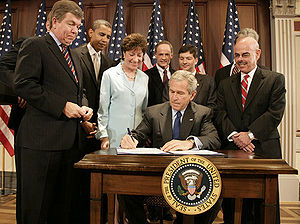 President George W. Bush signing the Federal Funding Accountability and Transparency Act of 2006 in the Eisenhower Executive Office Building, on September 26, 2006.
President George W. Bush signing the Federal Funding Accountability and Transparency Act of 2006 in the Eisenhower Executive Office Building, on September 26, 2006.
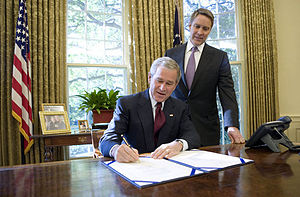 With Sen. Bill Frist (R-Tenn.) looking on, President George W. Bush signs into law Pub.L. 109-353, the North Korea Nonproliferation Act of 2006, on October 13, 2006.
With Sen. Bill Frist (R-Tenn.) looking on, President George W. Bush signs into law Pub.L. 109-353, the North Korea Nonproliferation Act of 2006, on October 13, 2006. Main article: List of United States federal legislation
Main article: List of United States federal legislation- February 17, 2005: Class Action Fairness Act of 2005, Pub.L. 109-2
- March 21, 2005: Theresa Marie Schiavo's law, Pub.L. 109-3
- April 20, 2005: Bankruptcy Abuse Prevention and Consumer Protection Act, Pub.L. 109-8
- April 27, 2005: Family Entertainment and Copyright Act, Pub.L. 109-9
- July 28, 2005: Dominican Republic-Central America-United States Free Trade Agreement Implementation Act (CAFTA Implementation Act), Pub.L. 109-53
- July 29, 2005: Energy Policy Act of 2005, Pub.L. 109-58
- August 10, 2005: Transportation Equity Act of 2005, Pub.L. 109-59
- October 26, 2005: Protection of Lawful Commerce in Arms Act, Pub.L. 109-92
- December 1, 2005: Caribbean National Forest Act of 2005, Pub.L. 109-118
- December 22, 2005: Presidential $1 Coin Act of 2005, Pub.L. 109-145
- December 30, 2005: Department of Defense Appropriations Act, 2006, Pub.L. 109-148
- February 8, 2006: Deficit Reduction Act of 2005, Pub.L. 109-171
- May 17, 2006: Tax Increase Prevention and Reconciliation Act of 2005, Pub.L. 109-222
- May 29, 2006: Respect for America's Fallen Heroes Act, Pub.L. 109-228
- July 27, 2006: Adam Walsh Child Protection and Safety Act, Pub.L. 109-248
- September 26, 2006: Federal Funding Accountability and Transparency Act of 2006, Pub.L. 109-282
- October 13, 2006: Safe Port Act, Pub.L. 109-347, including title VIII, Unlawful Internet Gambling Enforcement Act of 2006
- October 17, 2006: Military Commissions Act of 2006, Pub.L. 109-366
- October 26, 2006: Secure Fence Act of 2006, Pub.L. 109-367
- December 20, 2006: Stolen Valor Act of 2005, Pub.L. 109-437
- December 20, 2006: Tax Relief and Health Act of 2006, Pub.L. 109-432
Proposed, but not enacted
- H.R. 554 — Personal Responsibility in Food Consumption Act
- H.R. 810 — Stem Cell Research Enhancement Act of 2005 - Vetoed
- H.R. 1505 — Jessica Lunsford Act
- H.R. 4569 — Digital Transition Content Security Act
- S. 147 — Native Hawaiian Government Reorganization Act of 2005 (Akaka Bill)
- S. 2611 — Comprehensive Immigration Reform Act of 2006
More information: Complete index of Public and Private Laws for 109th Congress at U.S. Government Printing Office
Hearings
- Congressional response to the NSA warrantless surveillance program (Senate Judiciary; House Intelligence; Democrats of the House Judiciary)
See also: Congressional hearingParty summary
Senate
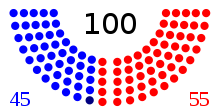 Party standings in the Senate during the 109th Congress
Party standings in the Senate during the 109th Congress 44 Democratic Senators1 Independent Senator, caucusing with Democrats55 Republican Senators
44 Democratic Senators1 Independent Senator, caucusing with Democrats55 Republican SenatorsThe party summary for the Senate remained the same during the entire 109th Congress. On January 16, 2006, Democrat Jon Corzine resigned, but Democrat Bob Menendez was appointed and took Corzine's seat the next day.
Affiliation Party (Shading indicates majority caucus)Total Republican Democratic Independent Vacant End of previous Congress 51 48 1 100 0 Entire Congress 55 44 1 100 0 Final voting share 55% 45% Beginning of the next Congress 49 49 2 100 0 Partisan mix of the Senate by stateState ranked in partisan order Percentage
RepublicansPercentage
DemocratsRepublican/
DemocratRepublican
seat pluralityAlabama 100% 0% 2/0 2 Alaska 100% 0% 2/0 2 Arizona 100% 0% 2/0 2 Georgia 100% 0% 2/0 2 Idaho 100% 0% 2/0 2 Kansas 100% 0% 2/0 2 Kentucky 100% 0% 2/0 2 Maine 100% 0% 2/0 2 Mississippi 100% 0% 2/0 2 Missouri 100% 0% 2/0 2 New Hampshire 100% 0% 2/0 2 North Carolina 100% 0% 2/0 2 Ohio 100% 0% 2/0 2 Oklahoma 100% 0% 2/0 2 Pennsylvania 100% 0% 2/0 2 South Carolina 100% 0% 2/0 2 Tennessee 100% 0% 2/0 2 Texas 100% 0% 2/0 2 Utah 100% 0% 2/0 2 Virginia 100% 0% 2/0 2 Wyoming 100% 0% 2/0 2 United States 55% 44% 55/44 11 Colorado 50% 50% 1/1 0 Florida 50% 50% 1/1 0 Indiana 50% 50% 1/1 0 Iowa 50% 50% 1/1 0 Louisiana 50% 50% 1/1 0 Minnesota 50% 50% 1/1 0 Montana 50% 50% 1/1 0 Nebraska 50% 50% 1/1 0 Nevada 50% 50% 1/1 0 New Mexico 50% 50% 1/1 0 Oregon 50% 50% 1/1 0 Rhode Island 50% 50% 1/1 0 South Dakota 50% 50% 1/1 0 Vermont 0% 50% 0/1
(1 independent)-1 Arkansas 0% 100% 0/2 -2 California 0% 100% 0/2 -2 Connecticut 0% 100% 0/2 -2 Delaware 0% 100% 0/2 -2 Hawaii 0% 100% 0/2 -2 Illinois 0% 100% 0/2 -2 Maryland 0% 100% 0/2 -2 Massachusetts 0% 100% 0/2 -2 Michigan 0% 100% 0/2 -2 New Jersey 0% 100% 0/2 -2 New York 0% 100% 0/2 -2 North Dakota 0% 100% 0/2 -2 Washington 0% 100% 0/2 -2 West Virginia 0% 100% 0/2 -2 Wisconsin 0% 100% 0/2 -2 House of Representatives
Due to resignations and special elections, Republicans lost a net of three seats; Democrats gained one seat; three seats were left vacant; and one seat which was vacant at the beginning of the Congress was filled. All seats were filled though special elections. (See Changes in membership, below.)
Affiliation Party (Shading indicates majority caucus)Total Republican Democratic Independent Vacant End of previous Congress 225 207 1 433 2 Begin 232 201 1 434 1 March 10, 2005 202 435 0 April 29, 2005 231 434 1 August 2, 2005 230 433 2 September 6, 2005 231 434 1 December 1, 2005 230 433 2 December 7, 2005 231 434 1 January 16, 2006 201 433 2 June 9, 2006 230 432 3 June 13, 2006 231 433 2 September 29, 2006 230 432 3 November 3, 2006 229 431 4 November 13, 2006 230 202 433 2 December 31, 2006 229 432 3 Final voting share 53.0% 47.0% Non-voting members 1 4 0 5 0 Beginning of next Congress 202 233 0 435 0 Partisan mix of the House by stateState ranked in partisan order Percentage
RepublicansPercentage
DemocratsRepublican/
DemocratRepublican
seat pluralityNebraska 100% 0% 3/0 3 Idaho 100% 0% 2/0 2 New Hampshire 100% 0% 2/0 2 Alaska 100% 0% 1/0 1 Delaware 100% 0% 1/0 1 Montana 100% 0% 1/0 1 Wyoming 100% 0% 1/0 1 Kentucky 83% 17% 5/1 4 Iowa 80% 20% 4/1 3 Oklahoma 80% 20% 4/1 3 Indiana 78% 22% 7/2 5 Arizona 75% 25% 6/2 4 Kansas 75% 25% 3/1 2 Virginia 73% 27% 8/3 5 Florida 72% 28% 18/7 11 Alabama 71% 29% 5/2 3 Louisiana 71% 29% 5/2 3 Ohio 67% 33% 12/6 6 South Carolina 67% 33% 4/2 2 Nevada 67% 33% 2/1 1 New Mexico 67% 33% 2/1 1 Utah 67% 33% 2/1 1 Texas 65% 35% 20/11
(1 vacancy)9 Pennsylvania 63% 37% 12/7 5 Michigan 60% 40% 9/6 3 Connecticut 60% 40% 3/2 1 Colorado 57% 43% 4/3 1 Missouri 56% 44% 5/4 1 Georgia 54% 46% 7/6 1 North Carolina 54% 46% 7/6 1 United States 53% 47% 231/201 30 Minnesota 50% 50% 4/4 0 Wisconsin 50% 50% 4/4 0 Mississippi 50% 50% 2/2 0 New Jersey 50% 50% 6/6
(1 vacancy)0 Vermont 0% 0% 0/0
(1 independent)0 Illinois 47% 53% 9/10 -1 Tennessee 44% 56% 4/5 -1 California 38% 62% 20/33 -13 West Virginia 33% 67% 1/2 -1 Washington 33% 67% 3/6 -3 New York 31% 69% 9/20 -11 Arkansas 25% 75% 1/3 -2 Maryland 25% 75% 2/6 -4 Oregon 20% 80% 1/4 -3 North Dakota 0% 100% 0/1 -1 South Dakota 0% 100% 0/1 -1 Hawaii 0% 100% 0/2 -2 Maine 0% 100% 0/2 -2 Rhode Island 0% 100% 0/2 -2 Massachusetts 0% 100% 0/10 -10 State ranked in partisan order Percentage
RepublicansPercentage
DemocratsRepublican/
DemocratRepublican
seat pluralityLeadership
[ Section contents: Senate: Majority (R), Minority (D) • House: Majority (R), Minority (D) ]
Senate
- President of the Senate: Dick Cheney (R)
- President pro tempore: Ted Stevens (R)
- President pro tempore emeritus: Robert Byrd (D)
Majority (Republican) leadership
- Majority Leader: Bill Frist
- Majority Whip: Mitch McConnell
- Republican Conference Chairman: Rick Santorum
- Republican Policy Committee Chairman: Jon Kyl
- Republican Conference Secretary: Kay Bailey Hutchison
- Republican Campaign Committee Chair: Elizabeth Dole
Minority (Democratic) leadership
- Minority Leader: Harry Reid
- Minority Whip: Richard Durbin
- Democratic Conference Chairman: Harry Reid
- Democratic Policy Committee Chairman: Byron Dorgan
- Democratic Conference Secretary: Debbie Stabenow
- Democratic Campaign Committee Chairman: Charles Schumer
House of Representatives

Majority (Republican) leadership
- Majority Leader: Tom DeLay, until September 28, 2005
- Roy Blunt, September 28, 2005 – February 2, 2006 ("Interim Leader")
- John Boehner, from February 2, 2006
- Majority Whip: Roy Blunt
- Senior Chief Deputy Whip: Eric Cantor
- Deputy Whip Team: Kevin Brady
- Assistant Deputy Whip Team: Doc Hastings
- Conference Chair: Deborah Pryce
- Conference Vice-Chair: Jack Kingston
- Conference Secretary: John T. Doolittle
- Policy Committee Chairman: John Shadegg, until February 2, 2006
- Adam Putnam, from February 2, 2006
- Campaign Committee Chairman: Tom Reynolds
Minority (Democratic) leadership
- Minority Leader: Nancy Pelosi
- Minority Whip: Steny Hoyer
- Senior Chief Deputy Whip: John Lewis
- Minority Deputy Whip Team: Diana DeGette
- Democratic Caucus Chairman: Jim Clyburn
- Democratic Caucus Vice Chairman: John Larson
- Assistant to the House Minority Leader: John Spratt
- Democratic Campaign Committee Chairman: Rahm Emanuel
- Democratic Steering Committee Co-Chairs: Rosa DeLauro, George Miller
Members
Senate
House of Representatives
Section contents: Alabama — Alaska — Arizona —Arkansas — California — Colorado — Connecticut — Delaware — Florida — Georgia — Hawaii — Idaho — Illinois — Indiana — Iowa — Kansas — Kentucky — Louisiana — Maine — Maryland — Massachusetts — Michigan — Minnesota — Mississippi — Missouri — Montana — Nebraska — Nevada — New Hampshire — New Jersey — New Mexico — New York — North Carolina — North Dakota — Ohio — Oklahoma — Oregon — Pennsylvania — Rhode Island — South Carolina — South Dakota — Tennessee — Texas — Utah — Vermont — Virginia — Washington — West Virginia — Wisconsin — Wyoming — Non-voting members The names of members of the House of Representatives are preceded by their district numbers.
Changes in membership
Members who came and left during this Congress.
Senate
State
(class)Former senator Reason for change Successor Date of successor's
installationNew Jersey
(1)Jon Corzine (D) Corzine resigned to become Governor of New Jersey on January 17, 2006. Bob Menendez (D) Appointed January 18, 2006 Connecticut
(1)Joseph Lieberman (D) Change of party affiliation Joseph Lieberman (ID) August 9, 2006 House of Representatives
District Vacator Reason for change Successor Date of successor's
installationCalifornia 5th None Representative Bob Matsui (D) died January 1, 2005 — before the end of the previous Congress. A special election was held March 8, 2005 Doris Matsui (D) March 10, 2005 Ohio 2nd Rob Portman (R) Resigned April 29, 2005 to become the United States Trade Representative. A special election was held August 2, 2005 Jean Schmidt (R) September 6, 2005[9] California 48th Christopher Cox (R) Resigned August 2, 2005 to become chairman of the U.S. Securities and Exchange Commission. A special election was held December 6, 2005 John Campbell (R) December 7, 2005[10] California 50th Duke Cunningham (R) Resigned December 1, 2005 after pleading guilty to conspiracy for bribes and tax evasion. A special election was held June 6, 2006 Brian Bilbray (R) June 13, 2006[11] New Jersey 13th Bob Menendez (D) Resigned January 16, 2006 to become a U.S. Senator. A special election was held November 7, 2006 Albio Sires (D) November 13, 2006[12] Texas 22nd Tom DeLay (R) Resigned June 9, 2006 after a series of criminal indictments. A special election was held November 6, 2006 Shelley Sekula-Gibbs (R) November 13, 2006[13] Florida 16th Mark Foley (R) Resigned September 29, 2006 after a teen sex scandal. Remained vacant until the next Congress.[14] Ohio 18th Bob Ney (R) Resigned November 3, 2006 after pleading guilty to conspiracy. Remained vacant until the next Congress. Nevada 2nd Jim Gibbons (R) Resigned December 31, 2006 to become Governor of Nevada. Remained vacant until the next Congress. Employees
- Architect of the Capitol: Alan M. Hantman
- Attending Physician of the United States Congress: John F. Eisold
Senate
- Chaplain: Barry C. Black
- Curator: Diane K. Skvarla
- Historian: Richard A. Baker
- Parliamentarian: Alan Frumin
- Secretary: Emily J. Reynolds
- Sergeant at Arms: William H. Pickle
- Secretary for the Majority: David J. Schiappa
- Secretary for the Minority: Martin P. Paone
House of Representatives
- Chaplain: Daniel P. Coughlin
- Chief Administrative Officer: James M. Eagen, III
- Clerk: Jeff Trandahl, until November 18, 2005
- Karen L. Haas, from December 1, 2005
- Historian: Robert V. Remini
- Parliamentarian: John V. Sullivan
- Reading Clerks: Paul Hays (R), Mary Kevin Niland (D)
- Sergeant at Arms: Wilson Livingood
- Inspector General of the United States House of Representatives: James J. Cornell
See also
Elections
- United States congressional elections, 2004
- United States House of Representatives elections, 2004, House elections for all members
- 2000 elections, 2002 elections, and 2004 elections: Senate elections for all Senators
References
- ^ a b Shepard, Scott (December 10, 2006). "109th may be the real 'do nothing' Congress". Cox News Service (Atlanta, GA). Archived from the original on June 05, 2011. http://web.archive.org/web/20110605113105/http://www.newsobserver.com/politics/story/519951.html
- ^ USA Today Editorial (December 11, 2006). "Our view on Congress wrapping up: 109th Congress' big success: Lowering the achievement bar". USA Today (MacLean, VA). http://blogs.usatoday.com/oped/2006/12/post_22.html#more[dead link]
- ^ "'Do-Nothing Congress' Raises Critics' Ire". This Week with George Stephanopoulos. ABC. 2006-05-12.
- ^ "The Cafferty File: Do-Nothing Congress". The Situation Room. CNN. 2006-12-04. cnn.com
- ^ "Goodbye To The Do-Nothing Congress". Face The Nation. CBS. 2006-12-10. cbsnews.com
- ^ Dobbs, Lou (August 2, 2006). "Five-weeks off for 'do-nothing Congress'". CNN. http://www.cnn.com/2006/US/08/01/dobbs.August2/index.html. Retrieved 2006-11-12.
- ^ Mann, T.brookings.edu; [[Norman J. Ornstein |Ornstein, N.]] (2006). OUP USA. N.Y., N.Y.: OUP USA. http://www.us.oup.com/us/catalog/general/subject/Politics/AmericanPolitics/LegislativeStudies/?view=usa&ci=9780195174465
- ^ a b c d e The Democratic-Farmer-Labor Party (DFL) is affiliated with the United States Democratic Party.
- ^ Ohio 2nd: A primary election was held on June 14, 2005. A runoff election was held on August 2, 2005. Jean Schmidt won and took her seat the next month. See Ohio 2nd congressional district election, 2005.
- ^ California 48th: A primary election was held on October 4, 2005. A runoff election was held on December 6, 2005. John Campbell won and took his seat the next day.See California 48th Congressional District Election, 2005.
- ^ California 50th: A primary election was held on April 11, 2006. A runoff election was held on June 6, 2006. Brian Bilbray won and took his seat one week later.See California 50th congressional district special election, 2006.
- ^ New Jersey 13th: An election was held to fill the unexpired term at the November 7, 2006 General Election. Sires was sworn in on November 13. See New Jersey 13th congressional district special election, 2006.
- ^ An election was held to fill the unexpired term at the November 7, 2006 General Election. Sekula-Gibbs took her seat on November 13.
- ^ 2 Election Winners to Fill Vacancies", via wtopnews.com
External links
- Biographical Directory of the United States Congress
- House History from the U.S. House of Representatives
- Statistics & Lists from the U.S. Senate
- Legislative information from THOMAS at the Library of Congress
United States Congresses (and years begun) 111 (2009)
112 (2011)
113 (2013)Categories:
Wikimedia Foundation. 2010.

